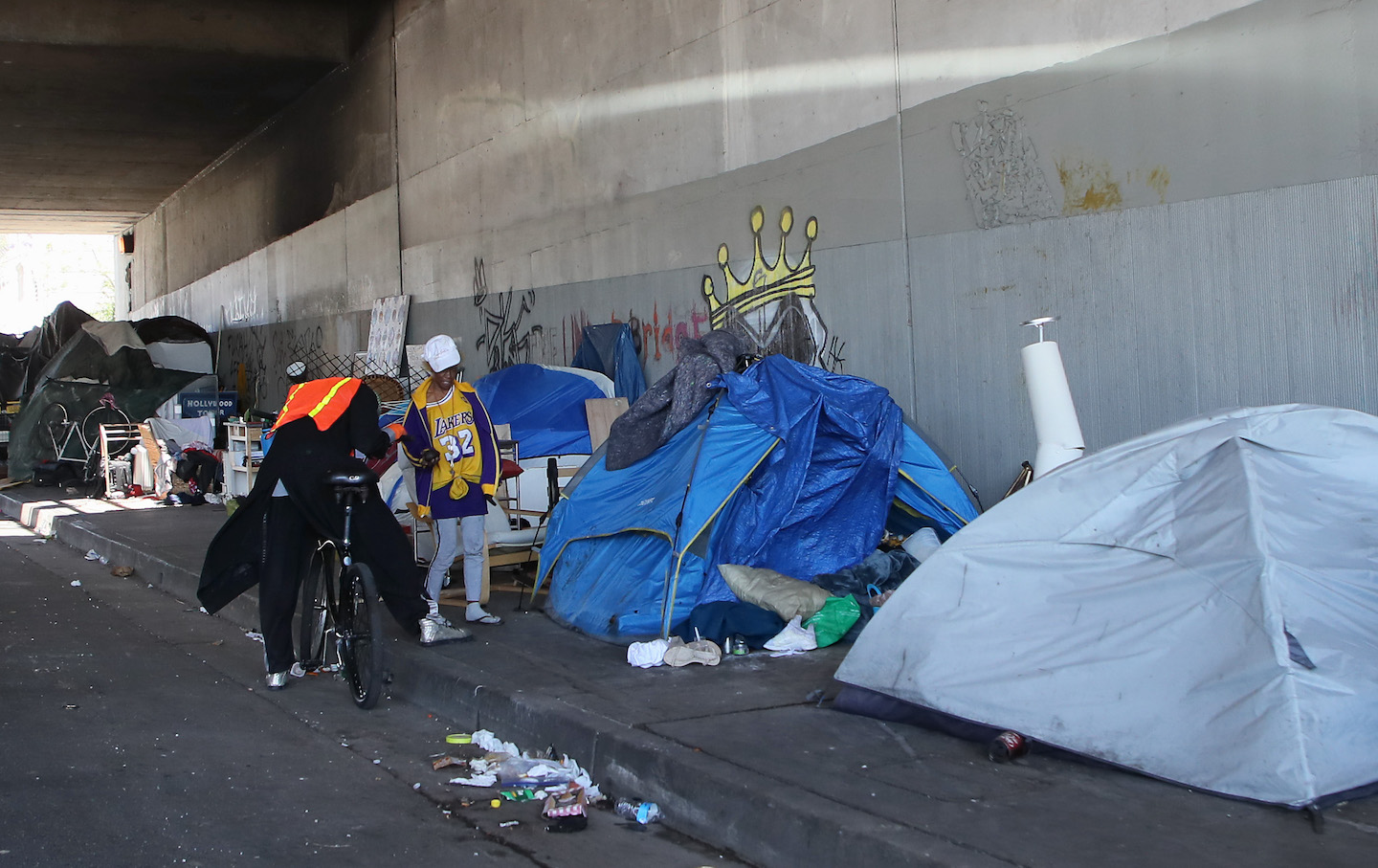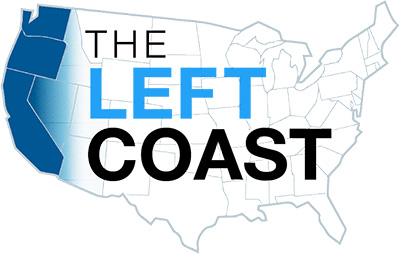
A homeless encampment under the 101 Freeway at Gower Street during the coronavirus pandemic on May 20, 2020 in Los Angeles, California. (David Livingston/Getty Images)

California’s gubernatorial recall election is now just months away; though exactly how many months remains to be seen, since no date has yet been set for the election.
Whenever it is, one of the things that makes Governor Newsom vulnerable is that, despite his rhetoric about (and increasingly large investments in) solving the state’s spiraling epidemic of homelessness, conditions on the ground tell a different story. In cities and towns around the state, homeless encampments and the often disturbing public behavior of seriously mentally ill people stand as reproof to claims the problem is being dealt with.
In 2015, only 2 percent of Californians polled by the Public Policy Institute of California listed homelessness as the biggest challenge facing the state. By early 2020, just before the pandemic knocked every other issue to the side, nearly a quarter of Californians listed it as the top policy concern for the state, making it far and away the leading issue. In a distant second place was a related issue—housing affordability.
In Los Angeles, freeway overpasses, as well as the underpasses, are lined with tents. There are tents perched at precarious angles on the earth berms coming off of freeways, and in river access points and parks. In Skid Row, on the eastern edge of Downtown, thousands of men and women live in encampments. On a smaller scale, similar conditions exist in pretty much every city in California.
Newsom recently announced that his newly revised budget would include an eye-popping $12 billion to tackle the crisis. That’s an increase of roughly 1,000 percent in the resources devoted to the challenge, and will—if implementation is not stymied by local zoning restrictions, NIMBYist public sentiment, and a dysfunctional local politics around the building of shelters—allow for the construction of 46,000 housing units catering to the state’s more than 150,000 homeless individuals.
This is all well and good. But it’s going to be extraordinarily hard to simply build one’s way out of a crisis that ties in with so many other social inequities: the decades-long push to mass incarceration in California, followed by decisions in recent years to lower the prison population without investing in housing, job training, and, above all, mental health services for those coming out of prison. (As I noted last week, surveys show that 70 percent of the state’s on-the-streets homeless have spent some time behind bars, and many of those individuals are suffering from serious mental illness.) The 1960s-era decisions to close most of the state’s in-patient mental hospitals left California without anywhere near the community mental health service infrastructure necessary to treat those in need. A spiraling opioid epidemic—an epidemic of despair, if ever there was one—that, in 2020, resulted in more San Franciscans dying of overdoses than of Covid-19.
Newsom’s leading Republican opponent at this point appears to be former San Diego mayor Kevin Faulconer. Faulconer has taken credit for policies that, after a major public health crisis in 2017 centered around hepatitis outbreaks in the encampments that afflicted hundreds of San Diegans, shifted several hundred long-term homeless people into more permanent housing. He also opened up safe spots where individuals living in their cars could park and sleep. The city calculated that these policies resulted in a 4 percent reduction in total homelessness, and a 12 percent reduction in on-the-streets homelessness.
That’s not insignificant; nor is it exactly earth-shattering. I’m in San Diego this week reporting a story for The Nation. This morning, before I sat down to write this column, I went to grab breakfast at a nice little waterfront café across the street from my hotel. The Embarcadero area is hardly low-end, but early in the day there were nearly as many homeless people as others out. While I waited in line to order coffee, a clearly unstable individual ran up to a woman waiting, with her puppy, to pick up her order, began screaming obscenities at her, and tried to physically attack the dog. Then, as quickly as he had arrived, he simply ran off. A few minutes later, as I sat at a table with my breakfast, a woman pushing her life possessions in a cart sat down at a nearby table and began having a long conversation with herself. A couple minutes after that, a young man entered the outdoor table area and, for no apparent reason, took off pretty much all of his clothes.
That’s what qualifies for “success” in Faulconer’s San Diego. I write that not to diminish the ex-mayor’s accomplishment in partially reducing the size of problem—and certainly the number of San Diegans who were homeless did decline slightly at a time when, in other California cities, it was increasing—but merely to point out that the project remains incomplete at best.
On the other hand, it’s not as if Democratic political figures—from Governor Newsom to Sacramento Mayor Darrell Steinberg—have figured out the magic formula either. Sacramento, where I live, is a town of half a million people where there are an unfathomable 5,500-plus on-the-streets homeless. The day before I left on this reporting trip, I was sitting in the outside patio of one of my local cafés when a man entered, began screaming at everyone inside the café, and then started punching the walls and the glass door before he was kicked out. A few minutes later, when I left the café, he followed me down the street, screaming epithets at me and repeatedly threatening to kill me. I managed to get into another café, where, by good luck, a police officer was having coffee. When we went outside so I could point the man out, he was already a block down the street, where he could be seen punching another stranger.
Party politics aside, the homeless and mental health crises playing out on the streets of cities throughout the Pacific West—for these affect Oregon and Washington as much as they do California—are unprecedented in scale and in severity. Bad public policies, embraced over the decades by both Republicans and Democrats, have created this humanitarian calamity. Half-hearted criminal justice system reform efforts in recent years have often just dumped people onto city streets without proper access to housing or support services, and with almost no chance of finding employment. Now, even in the season of the recall clection, where everything is being parsed for party advantage, it’s up to politicians of all ideological stripes to work out solutions rather than to simply point fingers.
Donald Trump’s cruel and chaotic second term is just getting started. In his first month back in office, Trump and his lackey Elon Musk (or is it the other way around?) have proven that nothing is safe from sacrifice at the altar of unchecked power and riches.
Only robust independent journalism can cut through the noise and offer clear-eyed reporting and analysis based on principle and conscience. That’s what The Nation has done for 160 years and that’s what we’re doing now.
Our independent journalism doesn’t allow injustice to go unnoticed or unchallenged—nor will we abandon hope for a better world. Our writers, editors, and fact-checkers are working relentlessly to keep you informed and empowered when so much of the media fails to do so out of credulity, fear, or fealty.
The Nation has seen unprecedented times before. We draw strength and guidance from our history of principled progressive journalism in times of crisis, and we are committed to continuing this legacy today.
We’re aiming to raise $25,000 during our Spring Fundraising Campaign to ensure that we have the resources to expose the oligarchs and profiteers attempting to loot our republic. Stand for bold independent journalism and donate to support The Nation today.
Onward,
Katrina vanden Heuvel
Editorial Director and Publisher, The Nation
While Republican Faulconer’s actions in San Diego did reduce homelessness to a degree, as will Democrat Newsom’s huge investments in housing units over the coming years, far more needs to be done. Mental health services and interventions also have to be dramatically expanded; drug treatment and overdose prevention methods should be made more widely and easily available; job training programs for ex-prisoners, as well as other homeless individuals, must be ramped up. And huge, ongoing, investments in affording housing must be made, at speed.
None of this will end homelessness in California, Oregon, or Washington overnight. But acting collaboratively, with thinking across bureaucratic and ideological boundaries, at the very least surely it ought to be possible to reduce the numbers of residents living out in the open, their mental well-being made ever more fragile by conditions on the streets, in some of the world’s wealthiest and resource-rich cities.
Sasha AbramskyTwitterSasha Abramsky is The Nation's Western correspondent. He is the author of several books, including The American Way of Poverty, The House of Twenty Thousand Books, Little Wonder: The Fabulous Story of Lottie Dod, the World's First Female Sports Superstar, and most recently Chaos Comes Calling: The Battle Against the Far-Right Takeover of Small-Town America.